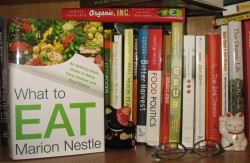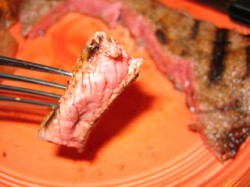The Locavore’s Bookshelf: What to Eat
When Marion Nestle sets out to write a consumer’s guide to food, she doesn’t mess around. She writes a big ole doorstop of a book, filled with facts and figures and some more facts and figures, and if you get tired of them, she throws a few more facts your way. The woman is a scientific powerhouse, with a PhD in molecular biology, and an MPH in public health nutrition, both from U.C. Berkeley. She’s written a great many articles, and several books, including the critically acclaimed (and really good book) Food Politics: How the Food Industry Influences Nutrition and Health, and Safe Food: Bacteria, Biotechnology and Bioterrorism.
Having said all that, I don’t want you to think that this magnificently large tome is boring. It isn’t. It isn’t because while Nestle has an unimpeachable scientific background, she is also capable of writing in a way which is engaging to her audience. And in this case, she is writing to the average grocery store shopper who wants someone to make sense of the ever-nagging question of what they should be eating for their health, for taste, and for the health of the planet. And she is able, though the use of personal experience and example, to write in a way that is engaging, and entertaining to such a person while still conveying significantly large amounts of information with every sentence.
Nestle is just the writer a consumer needs to go to so she can explain why transfats are bad, and whether or not they are as bad as regular plain old saturated fats. Her writing is deft and capable of unravelling the intricacies of eating fish: the debate between the heathy Omega 3 fatty acids that fatty carnivorous fish such as salmon and tuna have and the dangerous levels of methylmercury that these fish also store in their flesh from being at the top of the oceanic food chain is a tangled net of science, nutrition, and biology which she presents simply and factually in a way that a layperson can understand.
My one problem with the book so far–and I am only one third of the way through it as yet, but I think it is so important that I want to get the word out before I am done–is the density of information that Nestle presents. I don’t think it is a flaw, necessarily, but it does make it difficult to sit down and power through the book, as is my usual wont. Instead, I read it in small chunks of a chapter or two at a time, then I have to take time off in between to digest what I have read and integrate it into my previous accumulation of knowledge about food, the food industry, the USDA, the FDA and other such topics. For the average reader with no nutrition or scientific background, the book is probably most useful as a reference work that is delved into to answer certain questions as they arise, rather than something to be read cover to cover as I am doing.
I think that What to Eat is a comprehensive, fascinating look at the state of food in America today, with all the political and cultural implications that come with it. Nestle is a master at weaving societal and political concerns into her narrative seamlessly, while still ramming home every pertinent fact she wants the reader to comprehend now, and for eternity. Her chapters on meat, in particular, stand as well-deserved indictments of the laxity with which the USDA treats issues of public safety and health which should rile any half-way intelligent reader who gets her hands on the book.
Even though I am still working on getting through the book, I cannot recommend it enough; I cannot imagine that the rest of the book is going to be less worthwhile of a read than the first third of it. I give it an unqualified two thumbs up–grab it up, and read it. You will be glad you did.
Why I Eat Locally Produced, Pasture-Raised Meats
Allright, let’s talk turkey here.
Actually, let’s talk cow.
This is all about why I eat locally produced, pasture-raised beef*, even though it is much more expensive than the CAFO (concentrated animal feeding operations) or “feedlot” produced, factory farm meats available at every Walmart, Safeway and Kroger’s in the country.
My first reason is this: money isn’t everything.
Yes, I pay a higher price for the meat that I feed my family, my friends and myself, and I am proud to. I do this, because I think it is more important to spend a little more money up front to the farmer who raised those animals, and support local, humane agriculture and purchase a product that is not only much, much tastier and of higher quality, but is healthier and safer for us to eat.
Yes, I said it. Healthier and safer.
You don’t believe me?
Well, then hold onto your hats, because I aim to prove it to you.
First of all let’s talk about cattle. Cows, I mean. Those big critters that get ground up by the thousands so McDonald’s can sell tasteless hamburgers by the billions.
What did cows evolve to eat? (This is a rhetorical question–I don’t expect every city-dweller reading this essay to know the answer, as I am about to give it to you, so be patient.)
They evolved to eat grass. They are ruminants, which means they have a four-chambered stomach. One of these chambers is called a “rumen,” which is endowed with communities of symbiotic bacteria which help the cow digest that which would make us humans very sick if we tried to eat it: grass. Other rumimants include sheep, goats, deer, bison, antelope, and even giraffes. They “rumenate,” which means they regurgitate their food, chew it again (this is also known as “chewing cud”) and then swallow it, at which time, the symbiotic bacteria go to work pre-digesting much of the cellulose in the grass–which is the part of the plant that would make you and I very sick if we tried to eat it in any amount.
Rumenants are amazingly well-adapted at turning grass into energy and flesh. However, this process is not very fast–it takes cattle three to four years to grow to full weight on a pasture, however, when fed grass, these animals tend to be quite healthy and sturdy beasts. Their meat, is also of a different quality than the meat of an animal raised on the feed given on commercial feedlots. It is lower in saturated fat than grain fed beef, (and thus, is lower in calories) and it contains a higher percentage of healthy Omega 3 fatty acids than CAFO beef. In addition, it has higher levels of beta carotene and vitamin E than beef exclusively fed on corn and animal by-products and has significantly higher levels of Conjugated Linoleic Acid (CLA), a nutrient associated with lowering cancer risk.
You see, the food that is given on feedlots, which are feces-filled pens into which hundreds of cattle are crammed, is made primarily of corn, but is also supplemented with fat (often tallow–which is the rendered fat from cows), protein, which often comes from chicken litter–which is made up of chicken feces and feathers, chicken or pig blood, and other unsavory ingredients. Yes, I know that tallow, feathers, and blood are all foods that come from animal sources, which, if you think about it, means it probably shouldn’t be on the menu of an animal that is herbivorous. Yeah, making herbivores into carnivores creeps me out, too, which is why I will go out of my way to avoid CAFO meat. (My source for this information on exactly what feedlot cattle eat comes from Michael Pollan’s book The Omnivore’s Dilemma. However, the chapter which contains this information is based upon his New York Times article, “Power Steer,” which is available online. I highly suggest that you read that piece if you are in the least bit concerned with how animals are raised in CAFOs.)
I remember when my grandfather, the farmer who raised pastured Hereford cattle that were supplementally fed with field corn he grew himself, and molasses, read about feeding cows corn supplemented with fat and protein rendered from the waste of slaughterhouses. He said, shaking his head in disgust, “That is a damned stupid idea. Something bad will come of it.”
He was right. Something bad -did- come of it. BSE, bovine spongiform encephalitis, otherwise known as “mad cow disease.” It is a disease that, as near as scientists can tell, came about from turning cows not only into carnivores, but cannibals. (At least the practice of feeding cattle rendered cattle blood and protein was stopped in the US in 1997 in response to the BSE outbreaks in the UK; however, it is still allowable to feed calves cow blood, and all cattle -fat- derived from other cattle.)
Cows did not evolve to eat grain, much less grain that has been mixed with rendered fat from their own species, with rendered blood from their own or other species. Although cows will come to full weight in a remarkable seven months, when fed this fat-laden diet, they do not thrive on it. They get sick quite easily, in fact, with various illnesses, such as “bloat,” which comes about when the rumen fills with gas from being unable to properly digest corn. When a cow has bloat, the stomach expands, like a great balloon, and presses on the cow’s lungs, and will suffocate the animal, unless a long hose is pushed down its throat to relieve the pressure.
Other problems have arisen from the practice of raising cows in feedlots. For example, a cow’s stomach, when it eats grass, is naturally a neutral environment, however, when fed corn, it becomes acidified. This gives the cow a really bad case of acid reflux or heartburn, which in severe cases can kill the cow, but more often simply degrades its quality of life.
A worse consequence for that acidic stomach environment, from a human perspective, is the development of strains of e coli which are able to live and reproduce in an acidic environment, including the fatal 0157:H7. The strains of e coli that normally inhabited the gut of cattle was no match for human stomach acid, which, if a human accidentally ate meat tainted with it, would die in the stomach before it could infect the human and make him sick. The fatal strain, however, inured to the acidic stomachs of feedlot cattle, can survive our stomach acid and go on to kill us by either dehydration from severe diarrhea (this especially happens to the very young or the very old) or by destroying our kidneys.
Other diseases sicken feedlot cattle. Because of the crowded and filthy, feces-dust ridden conditions of the feedlot, cattle come down with pneumonia fairly often.
In order to keep animals healthy, to treat the sick animals who are commonly found in the feedlot, and to promote rapid growth in meat animals, CAFO cattle are fed high doses of antibiotics. This misuse of medicine results in the proliferation of resistant strains of bacteria–bacteria who are unaffected by normal doses of antibiotics. (In 1999, 40% of the estimated 50 billion pounds of antibiotics produced in the US went into animal feed.) This affects not only feedlot animals’ health, but it also affects human health, as the number of antibiotic-resistant strains of bacteria which infect humans rises. The CDC noted in 1999 a continual rise in foodborne bacterial infections, many of which resulted in death, because many of the bacteria were resistant to antibiotic treatment. (The USDA, however, which is at this point, in my opinion, nothing but a spokesperson for the meat industry, is of the opinion that more research is necessary before changing any policies that might limit meat industry profits, even if it is in the best interest of the American public to protect their health.)
Do you see what I mean when I say that the locally-raised, primarily pasture-fed beef that I am eating is both healthier and safer for me and my family to eat? I don’t particularly see the benefit in paying less for food that is not only less healthy for me to eat, but may also be contaminated with antibiotic-resistant foodborne bacteria.
Besides, I know that when I buy beef at the grocery store that the price that is marked is only part of the cost of that meat. I have already paid for a considerable amount of it in the form of taxes.
How so?
Well, the feed that goes to grocery store beef is mostly in the form of corn, which I have already paid for through government subsidies, which come out of my taxes.
The other costs that are not evident in the marked price of that cheap grocery store meat, are the public health issues that result from foodborne illness, the environmental toll taken by the waste runoff from CAFO feedlots, and the fact that the farmers who are growing the corn who are feeding those cows are seldom making a living wage themselves. Oh, and there is also the exorbitant cost of the petroleum that goes into growing each pound of corn those cows eat.
So, you see why I would rather pay a little bit more money to ensure better quality meat for my family and friends, a living wage for farmers, a cleaner, healthier environment and a stronger local economy.
Oh, and there is one other factor we need to put into this equation, and it is, in fact, what got Zak into the habit of eating local meat: taste.
It tastes so much better than grocery store beef. It tastes like the meat I grew up eating, which had a distinct beefiness that most meat from the grocery store lacks. (The same is true of all the locally raised meats–they all taste better and have a much better texture than grocery store meats. Once you taste them, you don’t want to go back.) It tastes, looks and smells so much better than grocery store meat that after the first couple of meals, Zak was sold on it and never looked back to the grocery store meat department again. He has never once complained about how much more we spend on meat than we did before, because it is worth every penny.
To find locally raised, grass-fed meats (and other farm-fresh foods) near to you, check out these links:
Eat Wild
Local Harvest
Farmers Markets
Sustainable Table’s Eat Well Guide
Farm Folk/City Folk
*The truth is–I not only eat locally produced pasture-raised beef, but also pork, lamb, goat, and chicken as well. I just figured it would be easier if I just used beef as the example, because the diseases that each animal can get through being raised in a crowded CAFO are distinct and it would be too confusing to go into each of them. So, to simplify, I decided to just talk about cows.
The Spice Is Right: Sweet Or Savory Round-Up Part III
Here we are again, with the final entries into the Spice is Right II–“Sweet or Savory?”
Once again, I really want to thank everyone for participating in this event with such fun, fascinating entries that have been a joy to read and write about. I hope that you all come back and play in the next round, entitled, “The Perfumed Garden.”
Luv2Cook, the blogger behind Cooking Medley, tells us all about how she used to help her mother and grandmother scrape the ginger roots clean before they were used. Yes, back then, she says, in India, ginger used to be sold with lots of red clay dirt clinging to it tightly, and so she and her cousins and siblings used to have the chore of scraping and washing the ginger clean, especially in the summer when kilos of it were bought to help preserve the pickles her mother and grandmother made. But she didn’t mind, because she so loved the smell of ginger, and she tells us that her family used it in nearly every savory dish they cooked. So, what did she present as her sweet dish? She made Ginger Shortbread Cookiesusing fresh, not powdered ginger. They sound delicious to me, and I bet they will to you, too.
Saffron is one of the most expensive spices in the world, but it is also nearly universally loved. Haalo, of Melbourne, Australia, and the author of Cook (almost) Anything at least Once, decided that since a very famous Italian dish that used saffron was the beloved Risotto Milanese, she would use saffron to flavor and color a classic Italian dessert–Panna Cotta. The results were beautiful, especially when she dressed up the Panna Cotta with a drizzle of Saffron Syrup: a golden confection of sugar, water and saffron threads. Her Saffron Panna Cotta with Saffron Syrup is a study in delicate flavor wedded to decadent texture and is not to be missed.
Vineela of Vineela’s Cuisine tells us that cloves are used in Indian cuisine to flavor biryanis, soups, in garam masala and to flavor some Bengali sweets. But, she wanted to try something new so she made a delightful-sounding version of baklava, the ubiquitous Greek or Turkish pastry made from phyllo dough. Phyllo, she tells us, is the Greek word for “leaf,” and the reason that the pastry is called that is because it is stretched into sheets as thin as paper. She carefully describes the care one must take when working with phyllo that it does not dry out, then presents her recipe which has a filling that includes cashews, almonds, pistachios, peanuts, coconut, and dried apricots and is flavored with cinnamon, cardamom and cloves. Wow–I want to go to Vineela’s house just so I can have a bite of her Sweet n Flaky Baklava.
Jen of bigdayton made a truly sumptuous recipe featuring vanilla, citing it as one of her favorite flavors and scents. (One of the trends, I see in this challenge has been to use vanilla in a savory context. Get on with yourselves, vanilla people!) I can’t help but agree with her–vanilla is beautiful–the pod of a gorgeous flower, with a scent that is on the one hand comforting and homey, and on the other hand, sensual and mysterious. She decided to pair it with garlic in a veloute sauce. What’s a veloute sauce? It is one of the classic French “mother sauces” from which many other sauces are derived–it is based on chicken stock thickened with a roux. The dish looks and sounds fabulous, and as Jen tells us, it is only nine Weight Watcher points, if you only eat half the sauce on the plate. So run off and read about her Chicken Scallopine with Vanilla and Garlic Veloute, and be prepared to lick your lips. (But, don’t lick the screen on your monitor–it is neither good for the monitor or your tongue.)
Now you -know- I just have to love this dish. It’s Chinese! A variant of red-cooked beef, which is braised in a spiced liquid that includes cinnamon, ginger and anise, spices that to most American palates are considered “sweet” and are relegated to baking and desserts. Rosie of Bitchin’ in the Kitchen had this dish in Vegas a few years back and fell in love and it has become a comfort food for her. Well, I tell you, I feel comforted just looking at it, but I also feel a mighty hunger welling up inside, too. I might have to sneak over to Rosie’s for a bowl of Cinnamon Beef Noodles–and the thing is, I -could- concievably do that, since she is just a hop, skip and a jump away in Columbus, Ohio. Watch out, Rosie! You may find me on your doorstep yet, fainting with hunger.
While I’m threatening hopping, skipping and jumping for a bite to eat, I feel like I should drop in on Lucette, of Cooking Vintage up in Cleveland. Not only because she likes to combine chocolate and chiles, but because she seems like a darned neat lady, too. But, really, that chocolate and chiles action helps a lot, too. Maybe I should organize a road trip and visit all the Ohio food bloggers, and have adventures with them and then blog about it. That could be fun! Where was I? Oh, yeah–Lucette’s Chocolate Chipotle Shortbread, which she says looks kinda like brownies, but has the sandy, texture and buttery flavor of shortbread, along with the smokey heat of chiles and the richness of chocolate. Wow. Sign me up for some of that! Now, Lucette says she adapted the recipe from two other recipes, and so the next time she makes these, she is going to change them a bit, but I think she is definately on the right track so far.
Cooking Theory, a native of India, whose self-named blog, Cooking Theory is brand new, wanted to make an unusual sweet for us. First, she wanted to use ginger, but was not sure it could be considered a spice (it is, just so she knows) and wanted to make a sweet, because so many spices are used in savory dishes in India. She wanted to make something unexpected. So, she decided to make Caraway Seed Cookies. In the US, we think of them as the flavoring agent in rye bread, so I think she picked a winner–unexpected flavors in an unexpected place. That is what this challenge is all about. Great job CT, thank you!
Linda, who is from the Netherlands, but is living in Tel Aviv (maybe I should introduce she and Hadar?) likes to make life sweeter by baking and creating sweets and confections, which is probably why she named her blog, Make Life Sweeter. It seems logical to me, anyway. So, what did she send in for our delectation? Well, she sent in a splendid recipe (alas no picture, but that is okay, we love her anyway) that utilizes curry powder in a completely unexpected way. She tells us that curry powder is always used in savory contexts in the Netherlands, so she wanted to step outside the mold and make a recipe using bittersweet chocolate ganache infused with curry. The resulting Curry Chocolates are then hand-dipped in bittersweet chocolate, which would make them go really nicely with Mackey’s chili chocolate truffles from the second round-up post. In fact, I think that the two should get together and open a chocolate shop.
Raspberry Sour of Toronto, the author of The Sour Patch, decided to take on cinnamon as her topsy-turvy spice of choice, and let’s listen to what she has to say about it: “My spice is cinnamon, most often spotted adorning various toasts, buns, pies, and rouglach about town. Only in North America would cinnamon be forever relegated to such mundane, pedestrian duties. Perhaps fearful of the ensuing flavour explosion, we have kept it safely corralled behind saccharine gates. Not so for the rest of the world, where cinnamon is routinely called upon to strut its stuff on the runways of flavour, dabbling in sweet and savoury as the mood strikes.” I couldn’t have said it better myself. So, what savory dish did she choose to de-sweetify her cinnamon? Moroccan Chicken Qdra, which sounds and looks lovely.
And here we are, at the end, with the hostess’ humble entry. I grew up with cinnamon used in sweets, just like most everyone else in the US, and my first introduction to cinnamon in savory dish was not successful. I still cannot abide Cincinnati chili to this day, but I have learned to love cinnamon used in Greek, Persian, Mexican and Indian savory dishes. So, what did I choose to present for this feast of Sweets and Savories? I chose to make Galavat Kebab, which are made with minced lamb spiced with fresh mint, garlic, and freshly made garam masala which features cinnamon prominently. The kebabs were fried in oil which had been infused with two cinnamon sticks, and then on the side, I served Green Chutney, which is made with shallots, fresh mint, cilantro, chiles, green garlic and coriander seed.
Thus ends the round-up of entries for The Spice is Right II: Sweet or Savory? I hope everyone enjoyed the game, thus far, and once again, it looks like we have a great bunch of recipes to read, play with and try out over the next month. Join us next time with the challenge, “The Perfumed Garden,” where I ask participants to mix edible flowers with spices in a dish.
If I missed anyone else (as I did miss Jen), just email me, and I will edit you into the round-up, with many apologies.
Announcing the Spice is Right III Theme
The theme for the June edition of The Spice is Right will be–drumroll please–“The Perfumed Garden.”
“What is she on about now?” I am sure you are wondering.
Well, it is easy–I want you to combine edible flowers in some form or another, with spices in a recipe. You can give us cultural notes about the flower, historical background on its use, your inspiration for why you chose it, or whatever you like in the post. You can tell us how the plant grows, and how you harvested it–however you would like to do that.
You also do not -have- to use fresh flowers to fulfill the idea of this challenge. You can use extracts (kewra or rose for example), waters (rosewater or orange-flower water), dried petals or flowers (lavender buds or rose petals), essential oils–in very small amounts (violet or lavender) or preserves (rose petal jelly or gulkand).
If you use any of these items, be certain they are food grade, and are from flowers not treated with chemical pesticides. (Frontier and Aura Cacia essential oils are organic, for example.) Do not use rosewater mixed with glycerine, but simply distilled water that has been scented with pure rose oil. The best way to assure that your flower waters are meant to be used not as perfumes but as flavoring agents is to buy them at a grocery store rather than a drugstore.
If you use fresh flowers, follow these few simple rules. One, make sure that the flower is truly edible. If in doubt, don’t eat it–there are plenty of books and websites out there about edible flowers. Two, make sure that the flowers are from a grower who doesn’t use chemical pesticides on it. (The best way to assure that is to grow them yourself or to get them from a neighbor or family member.)Three–wash it very well–wee bugs like to hide in the petals of plants and surprise you by appearing on top of your cake right before you serve it. Yes, this has happened to me. Yes, it is embarrassing!
Have fun with this one. Be adventurous and creative. Let the flowers be your palette and the scents and flavors your paints for a masterpiece.
I look forward to seeing what you come up with!
And, as always, if you have questions, or need help, email me or post here and ask.
The entry rules are the same as always–when you make your entry post, leave a link back to this post, (that way, if your readers want, they can come play, too) email me a link to your post, with your name as you want it to appear in my round up along with nationality if it is important to you. (This will also forstall me guessing and getting it wrong again!) The deadline is midnight June 15th, and the roundups will appear in the next couple of days after the deadline.
Any questions?
Look for the final round-up post for The Spice is Right II either this evening or tomorrow morning!
Note: All of the photographs that are illustrating this post come from the garden at our old house in Pataskala. You can see why we miss the garden so much!
The Spice Is Right: Sweet Or Savory Round-Up Part II
We’re back again with part II of our exploration of spices in The Spice is Right II: Sweet or Savory? Rather than take up time and space with my yammering, lets jump right in and look at what the next ten participants have prepared to share with us.
Strawberries aren’t in season in Canada where Elizabeth of Blog from Our Kitchen is cooking, but that didn’t stop her from giving us a truly decadent, delectable and delicious recipe for them using black pepper, balsamic vinegar and cream cheese. In Fresh Strawberries with Creamy Cream Cheese Topping, the pepper and the balsamic vinegar work alchemically to boost the natural flavors and sweetness of the strawberries while the lightly sweetened cream cheese adds sensual appeal to the dessert, elevating it to a realm where legendary flavors reside. I can’t wait to adapt this recipe to my usual method of making strawberry shortcake that involves cream scones, sweetened sour cream and berries laced with rosewater….I may have to make two separate batches of berries and cream and try them side by side and see which I like better.
Ramya of Cascading Flavors brings us information on nutmeg: how it is grown, itschemical constituents and its history. She tells us that once it was one of the most valuable spices in Europe, and although it is often used in sweet dishes there, in her native India, it is always used in savory foods. So, she switches it up, and makes a really tasty-sounding batch of Oatmealdates Cookies, which are sweetened with the natural goodness of dates and orange juice, not sugar. I cannot help but love that–a sweet treat that is not only tasty, but filled with healthy ingredients like oats, dates and orange juice.
I am sad to say that there is no photograph to go with this next entry; instead of a picture, we must rely on the author’s powers of description to whet our appetites. Fortunately, the blogger behind Raven Swallows the Sun has the lyrical prose to do just that: make the reader hungry for more. Shreyas, from India, took up the challenge by taking on vanilla, a flavor previously only encountered in ice cream and Nilla Wafers eaten with tea. The Queen of Spices is paired with meat, Tejano Steak, to be precise. Listen to what Shreyas says after the ingredients are listed: “Pay particular attention to the items in bold. This is where you turn lead into gold, or in this case, cow into joy. Everything else is built around them to balance or support—the ancho and pepper round out the smokiness of the cumin, the lemon brightens the vanilla, and the salt and garlic tie everything together….” My word, Shreyas, you are well on your way to kitchen tantrikadom yourself! (Besides, you gave me the idea for the next challenge–I tip my toque to you.)
I am quite thrilled to introduce the next entry, because it comes from one of my dearest friends in the world, whom I habitually call Little Sister. Hadar has gone and started a wonderful food blog from Tel Aviv called Vegetable Adventures, where she describes her explorations in vegetarian cookery, health, Chinese medicine, organic local foods and the importance of listening to the wisdom of our bodies. This is all written with her characteristic style and wit, so I hope you all check in on what is going on in her kitchen. What spice did she highlight for this challenge? Oh, one of the oldest ones in the world–sesame–in the form of tchinas, also known as tahini. She gives us two recipes, Stir-Fried Vegetables and Tofu with Tchina Sauce, and the equally healthful and delightful
Tchina Cookies with Coconut Milk and Spices, which are pictured. Welcome to the food blogging world, Hadar! I look forward to reading more of your adventures!
Jocelyn has returned for a second round of spice blogging, and this time, the author of She Spills the Beans declares herself to be a “one-woman Anise Advancement Association.” Anise is typically used in the west to flavor an old fashioned sweet called licorice, which has fallen out of favor, but Jocelyn doesn’t let that stop her. Nor does she let the fact that she is taking part in the Eat Local Challenge slow her down–she is happy to report that most of the vegetables for this dish came from the local farmer’s market, even if the spices didn’t. She paired local fresh baby fennel bulbs (which has a similar, but more delicate and vegetal flavor to anise) with anise and created what must be an amazingly fragrant Tomato-Fennel-Anise Soup. I just wish I could hop on over to Jocelyn’s house for lunch!
My favorite FoodFreak, Petra, has gone and created a recipe which has my heart going pitter-pat. It is enough to make me wish I could jet off to her house after eating at Jocelyn’s because she has taken up the familiar sweet spice, vanilla, and has paired it with my favorite seasonal vegetable, asparagus. Oh, my, such culinary wickedness and daring, and such alluring richness is arrayed in her description of Oven-roasted Asparagus with Vanilla Hollandaise. I can feel my eyes rolling back in my head right now, as my cheeks flush and I feel faint at the though of such a heavenly mixture of flavors and textures.
You know, when people use the term “vanilla” to describe someone who is plain and boring, I think that they don’t know what vanilla is really like. Because if it was the plain jane of the spice world, this many folks wouldn’t be playing with it and coming up with new ways to use it in the savory kitchen. Jasmine, a very -not boring- individual, the blogger who writes Confessions of a Cardamom Addict, would not play with vanilla if it was passe. What does our intrepid Canadian do with this royal flavor? Well, she limped into the kitchen (her poor ankle is still bothering her) and made adapted her usual Chicken Kurma recipe into Vanilla Kurma, a very mild, almond-kissed chicken kurma scented with the richness of vanilla. Brava!
Michael the ever-experimental author of Haverchuck, has a series of posts that he calls “The Ice Cream Project,” wherein he concocts various unusual flavors of ice cream (only one time for each recipe) and writes up his results. So, it isn’t the least bit surprising that he chose to do an ice cream for this challenge, nor am I surprised that he chose to use a spice typically used in Asian foods both savory and sweet: black sesame. Yes, sesame seeds can be black as well as white, and both are used in the unique pastry arts of Shanghai (my favorite being a flaky little number filled with black sesame paste sweetned with sugar and seasoned with salt–they are amazing.) Anyway, take a look at his Black Sesame Ice Cream–I like the granite shade of it, and I think that while his taste testers were divided on it, that I would have found it definately interesting and worth a second taste. And then a third, you know, just to make sure.
Benjamin, of The Cognitive Pantry, tells us all about being a cultural mutt–his ancestry, like many Americans is a little bit of this and that from Northern Europe, with some Cherokee thrown in for good measure (I’m the same–those Cherokee got around, I’m tellin’ you), before he starts telling us about Grandma Reba’s sausage gravy and biscuits. Grandma Reba sounds like my kind of woman, throwin’ down and making big breakfasts, including sausage gravy that was heavily seasoned with black pepper. Right on, Grandma! Turning the story around, though, Benjamin tells us how his parents lived in Germany in the 1970’s and how much they liked the food there. In tribute to that, he presents us with a traditional German Yuletime cookie–Pfeffernuesse. The word translates roughly as “peppernuts” and some versions of the cookie are so crunchy as to be tooth-endangering, but Benajamin’s sound delicious and crisp and good, with the pepper giving them a subtle, smoky tang. They certainly look pretty, don’t they?
I want to introduce you to Isis, and while she doesn’t have a photograph of either of the recipes she chose to highlight on her blog, Yambalaya, those recipes still sound too tasty to resist. Of Dutch/Greek lineage, Isis is living, cooking and working on a cookbook in France, though she has lived all over the place, and in her entry she shows us two sides of nutmeg. She chose to reveal nutmeg’s sweet side by teaching us how to make genuine Dutch Speculaas. She says, “I really liked this challenge and at first had no idea what I could prepare… until … I thought of speculaas. The real version, not the one we find in Belgium or in France, or .. No the real Dutch one. The one we start eating in November when it is cold and rainy, in thick pieces, with hot chocolate milk. The one we eat around the festivities of St Nicolas.” Mmm…thick hot chocolate and spice cookies. The Dutch know how to handle grey November rain. But then, she turns it around and gives us a recipe for Cauliflower with a Bechamel sauce sprinkled with nutmeg that sounds very nutty-sweet and good. I really don’t think anyone could go wrong trying either recipe.
Powered by WordPress. Graphics by Zak Kramer.
Design update by Daniel Trout.
Entries and comments feeds.

























